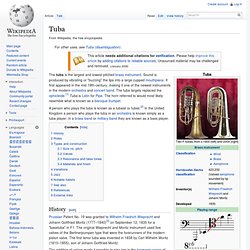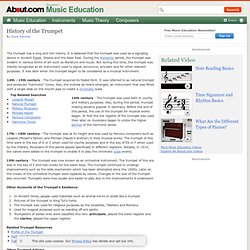

Beginning Band: Trombone Information. Trombone The trombone is a member of the brass family.

As with all brass instruments, the sound is produced by buzzing the lips into a mouthpiece. A unique feature of the trombone is the slide. While other brass instrument change pitches by pressing valves to change the length of the air flow, the trombone player simply moves the slide in and out to the change the length of the instrument. Students who play the trombone should have a good ear and be able to sing in tune. Taking care of a trombone is slightly more difficult than the other brass instruments.
The trombone is played with the bell on the left side of the slide. Almost all trombones come in just one size. The trombone is not nearly as popular as the trumpet or clarinet. The trombone is considered one of the most widely used instruments. There are several good choices for purchasing a beginning trombone. Purchasing a used trombone can be a good option if it is purchased with some caution. Recommended Instruments. Facts About Trombones. Interesting Facts About Tubas. Tuba. History[edit] Prussian Patent No. 19 was granted to Wilhelm Friedrich Wieprecht and Johann Gottfried Moritz (1777–1840)[3] on September 12, 1835 for a "basstuba" in F1.

The original Wieprecht and Moritz instrument used five valves of the Berlinerpumpen type that were the forerunners of the modern piston valve. The first tenor tuba was invented in 1838 by Carl Wilhelm Moritz (1810–1855), son of Johann Gottfried Moritz. Adolphe Sax, like Wieprecht, was interested in marketing systems of instruments from soprano to bass, and developed a series of brass instruments known as saxhorns.
The instruments developed by Sax were generally pitched in E♭ and B♭, while the Wieprecht "basstuba" and the subsequent Cerveny contrabass tuba were pitched in F and C (see below on pitch systems). Roles[edit] An orchestra usually has a single tuba, though an additional tuba may be asked for. Well known and influential parts for the tuba include: Types and construction[edit] Size vs. pitch[edit] Valves[edit] Trumpet - History of the Trumpet. The trumpet has a long and rich history.

It is believed that the trumpet was used as a signaling device in Ancient Egypt, Greece and the Near East. During the Romantic period, the trumpet was evident in various forms of art such as literature and music. But during this time, the trumpet was merely recognized as an instrument used to signal, announce, proclaim and for other relevant purposes. It was later when the trumpet began to be considered as a musical instrument. 14th - 15th century - The trumpet acquired its folded form. 16th century - The trumpet was used both in courtly and military purposes. 17th - 18th century - The trumpet was at its height and was used by famous composers such as Leopold (Mozart's father) and Michael (Haydn's brother) in their musical works. 19th century - The trumpet was now known as an orchestral instrument.
Other Accounts of the Trumpet's Existence: History of the Trumpet and Cornet. How It All Began The history of all musical instruments begins with the very young, as has been demonstrated through a variety of recent studies concerning the behavior and development of children.

Unlike adults, children “play.” This is where they explore and develop their life skills, including verbal, vocal, communication and language skills. Children have many times the ability of adults to assimilate, manipulate, and create whole new vocabularies and languages. Recent studies into the history, taxonomy and origin of language itself, point to children as the original creators and developers of language.
Children instinctively test the limits of their own physical capabilities and explore their immediate surroundings and environment in ways that adults do not.